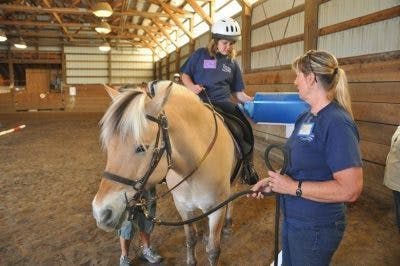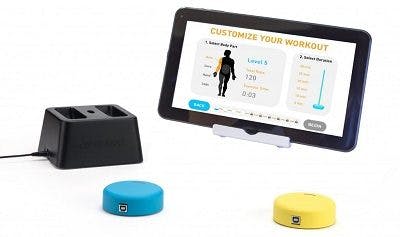Continuing Education Conferences Physical Therapists on Cerebral Palsy
Physical therapy plays an essential role in the management of cerebral palsy. It helps individuals improve their motor functions through targeted exercises.
To help you understand what cerebral palsy is and what it can involve, this article will discuss:
- Goals of Physical Therapy for Cerebral Palsy
- Exercises and Methods That May be Involved in PT for CP
- For How Long is Physical Therapy for Cerebral Palsy Necessary?
- How to Maximize the Effects of Physical Therapy at Home
Goals of Physical Therapy for Cerebral Palsy
Because cerebral palsy encompasses a wide range of neurological motor impairments at varying severities, a personalized exercise regimen is ideal for optimizing each individual's motor functions.
Physical therapy for cerebral palsy is effective because it promotes the brain's ability to make adaptive changes based on our actions (neuroplasticity). Neural pathways in the brain are always changing in response to motor activity. They can change for the better or worse, depending on one's behaviors.
Ultimately, the more you perform an action, the stronger the neural pathways in the brain for that action become. Think "use it to improve it." Likewise, neglecting an action may cause its neural pathways to weaken. Think "use it or lose it."
Physical therapists help identify what functions individuals with cerebral palsy need help improving and develop personalized rehabilitation plans to help them reach their functional goals. Through highly repetitive, task-specific exercises, individuals with cerebral palsy can promote neuroplasticity and achieve their optimal functional potentials.
In the following section, we'll discuss different types of physical therapy exercises an individual with cerebral palsy may participate in.
Exercises and Methods Involved in Physical Therapy for Cerebral Palsy
Cerebral palsy can affect various regions of the body. For some, motor impairments only affect the legs. For others, one side of the body or the entire body can be affected.
Below, we'll go over various exercises and physical therapy methods that may be suggested for an individual with cerebral palsy.
1. Stretches

At physical therapy, individuals can learn effective ways to stretch their affected muscles.
Over 80% of individuals with cerebral palsy experience high muscle tone, also known as spasticity. Due to the brain damage that caused the CP, motor signals from the brain are disrupted and the muscles remain contracted involuntarily.
While damage to the brain won't worsen over time, poorly managed spasticity can. The muscles can progressively tighten, which may result in limited range of motion, poor posture, abnormal movement patterns, uneven growth, and chronic pain.
As a result, frequent stretching is a must for most individuals with cerebral palsy. It helps stabilize muscle tone, minimize strain on the muscles and joints, and maintain full range of motion.
Discover stretches that a physical therapist may recommend to individuals with cerebral palsy »
2. Range of Motion Exercises
All individuals with cerebral palsy can benefit from practicing range of motion exercises.
Those with severe cerebral palsy often participate inpassive range of motion exercises. These are when a trained caregiver or therapist moves the client's body for them, helping them to stretch their muscles and gain motion in their joints. While they aren't exerting any energy, individuals with CP may still benefit from the stimulation, which promotes flexibility and circulation.
In contrast, individuals that have more muscle control should be encouraged to practice range of motion exercisesactively (on their own) as much as possible. This may help strengthen the neural connections for those movements and improve overall motor control.
Sometimes, a physical therapist may use active assistive range of motion exercises, where the therapist helps the individual with cerebral palsy to complete the targeted motion. This allows the individual to do as much as they are able to, while the therapist is able to help them move farther than they can independently to potentially gain more active motion.
Physical therapists may also encourage performing range of motion exercises in different positions to increase or decrease their intensity. For example, when performing range of motion exercises for raising the arm (shoulder flexion), the individual has to use more strength to fight against gravity when standing or sitting upright than when lying on their back.
3. Strengthening Exercises
Strengthening exercises are an essential part of physical therapy for cerebral palsy because they increase muscle power, flexibility, posture, and balance. When these functions are optimized, individuals are more likely to be active and perform daily activities on their own.
Based on the client's functional assessment, physical therapists determine which exercises are ideal for weak or underused muscles. Then, they guide the client through the exercises to make sure the correct muscles are being targeted in a safe and challenging manner.
4. Constraint-Induced Movement Therapy (CIMT)
Individuals who are only affected on one side (hemiplegic cerebral palsy) may be recommended a method called constraint-induced movement therapy (CIMT).
It involves restraining the use of the unaffected hand and intensive activity-based training with the affected hand. Ideally, by continuously using the affected hand, the brain is encouraged to make adaptive changes and strengthen the neural pathways for those functions.
Although it has not yet been frequently used or researched among individuals with cerebral palsy, constraint-induced movement therapy may also be used to target an affected leg.
Learn more about constraint-induced movement therapy for cerebral palsy »
5. Gait Training

Gait training is a type of physical therapy that focuses specifically on improving walking functions.
Many individuals with CP may walk with an abnormal gait due to spasticity in the legs. During gait training, a physical therapist may focus on increasing walking speed or correcting walking form. Correcting abnormal gait patterns is essential because poor form can ultimately compromise function and potentially lead to the development of chronic pain.
Gait training may involve the use of equipment such as walkers, bodyweight supporting treadmills, and parallel bars to help individuals practice walking without losing stability. Additionally, a PT may recommend wearing orthotics such as a leg brace to support correct musculoskeletal alignment and gently stretch spastic muscles.
Learn more about gait training for cerebral palsy »
6. Aquatic Therapy
Aquatic therapy is a form of physical therapy that takes place in a pool. Being submerged in water allows individuals to feel weightless, which enables them to focus on developing their form without straining the joints. Additionally, moving against the resistance of water helps mildly strengthen the muscles.
Learn more about aquatic therapy for cerebral palsy »
7. Hippotherapy

Hippotherapy can help individuals with cerebral palsy improve their balance, coordination, and posture while riding on the back of a horse. It provides a unique, multi-sensory experience that helps keep individuals engaged.
Additionally, the movements of the horse provide a repetitive, rhythmic pattern that is similar to how humans walk. As a result, it may contribute to improvements in an individual's gait.
Learn more about hippotherapy for cerebral palsy»
8. Games and Activities
When working with children, physical therapists may employ fun games and activities in addition to exercises to encourage the carryover of skills learned in therapy to a child's daily life. This may include using obstacle courses, balance games, or even employing technology such as Wii Fit.
Ultimately, the key to improving motor functions is to keep moving. Teaching children fun, engaging activities that they can play at home can be an effective way to promote movement outside of physical therapy sessions and increase the carryover of skills and improvements.
Discover games and activities for children with CP »
For How Long is Physical Therapy for Cerebral Palsy Necessary?
Cerebral palsy is a lifelong condition that requires consistent management.
The brain damage that caused CP is static, meaning that it will not worsen over time. However, if not consistently managed, effects of cerebral palsy like spasticity can progress. Therefore, it's essential to prioritize exercises you learn from PT and incorporate them into your daily routine.
The majority of individuals with cerebral palsy regularly go to physical therapy as children. Some individuals may go to physical therapy consistently for long periods of time, while others pursue physical therapy for shorter periods of time to focus on developing a certain skill. They then may take a break from physical therapy to continue solidifying that skill at home, and resume therapy when they determine a new skill to focus on.
However, as individuals with cerebral palsy get older, many stop going to physical therapy altogether. This may be because they assume they've reached a point where they'll no longer improve. While motor impairment levels generally remain consistent after a certain age, there are reported instances of individuals improving their functional mobility in adulthood.
Younger brains have higher levels of neuroplasticity, which allows children to learn new habits at a quicker rate. However, the brain never runs out of neuroplasticity, which means as long as individuals continue to stimulate their brains through repetitive exercise, the potential to improve is still there.
Maximizing the Effects of Physical Therapy for Cerebral Palsy at Home

In order to maximize the effects of physical therapy, it is essential to also practice exercises in-between sessions. This helps consistently stimulate and strengthen neural connections in the brain.
However, without a physical therapist present, individuals often struggle with accountability and quickly lose the motivation to exercise. Using interactive home neurorehabilitation devices like the FitMi can help keep individuals with cerebral palsy engaged and practicing the repetitions they need to improve their motor functions.
FitMi combines gaming and therapy to challenge individuals to reach a certain number of repetitions within a given timeframe. The sensorized pucks provide biofeedback and help users keep track of their progress. FitMi also adapts to each individual's ability level so that they're challenged just the right amount.
Improving motor functions affected by cerebral palsy requires consistent stimulation, and FitMi helps motivate users to keep going.
Physical Therapy for Individuals with Cerebral Palsy: Key Points
Physical therapy can help individuals with cerebral palsy significantly improve their motor functions through task-specific, highly repetitive practice. By consistently stimulating the brain, individuals can promote neuroadaptive changes and develop new habits. Furthermore, interactive physical therapy tools can help motivate you to be consistent with your regimen.
We hope this article helped you understand the importance of personalized physical therapy and that even amongst individuals with cerebral palsy, physical therapy interventions can significantly vary.
rodriquezauntrand1975.blogspot.com
Source: https://www.flintrehab.com/cerebral-palsy-physical-therapy/
Post a Comment for "Continuing Education Conferences Physical Therapists on Cerebral Palsy"